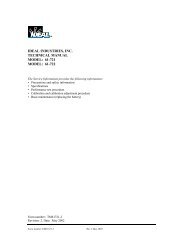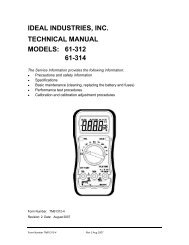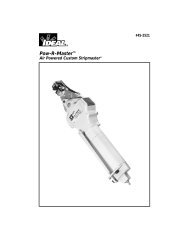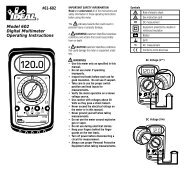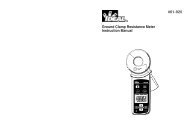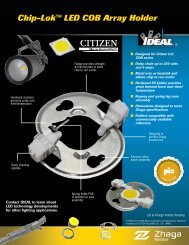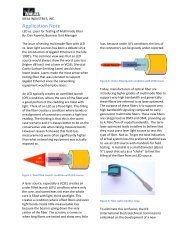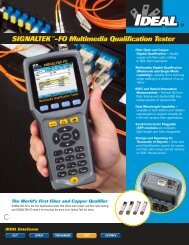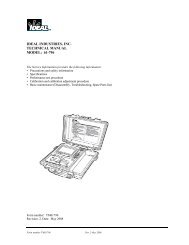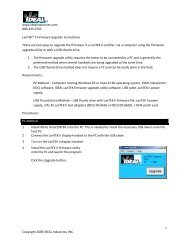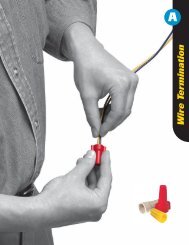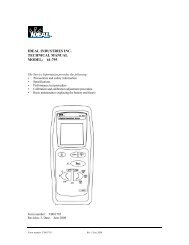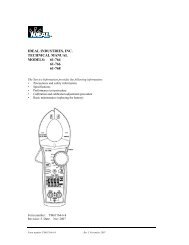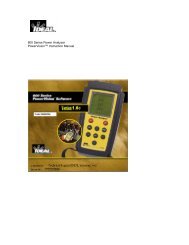PDF Version - Ideal Industries Inc.
PDF Version - Ideal Industries Inc.
PDF Version - Ideal Industries Inc.
You also want an ePaper? Increase the reach of your titles
YUMPU automatically turns print PDFs into web optimized ePapers that Google loves.
Insulated Screwdrivers & Nutdrivers – More Torque<br />
and More Safety<br />
IDEAL insulated screwdrivers and nutdrivers are VDE certified to<br />
1000V AC. Each one is designed to meet ASTM F1505-01, EN,<br />
DIN and IEC 60 900 test standards.<br />
Features<br />
• Tempered blades are finished with black oxide and super<br />
hardened for maximum quality<br />
• Tools are certified to 1000V (1000V AC, 1500V DC)<br />
• Precision ground tips provide secure fit for less spin-out<br />
• Meets OSHA requirements for insulated tools (29 CFR 1910)<br />
Precision-ground<br />
tips provide secure<br />
fit for less spin-out<br />
Insulated Tools<br />
Molded-on insulation<br />
provides permanent<br />
bonding<br />
Tempered chrome vanadium<br />
tool steel blades are super<br />
hardened for maximum quality<br />
Whenever possible, always de-energize lines and equipment<br />
prior to working on or around them. 1000V insulated tools are<br />
designed only to reduce the chance of injury where the tool may make contact<br />
with an energized source. Work around energized circuits should only be done<br />
when absolutely necessary and only by qualified technicians. Property damage,<br />
personal injury or death may result if the following warnings are not heeded:<br />
• Do not use any insulated tool if the insulation cracks, breaks or becomes<br />
damaged in any way. Destroy all dual-layer tools if the inner yellow layer<br />
shows through the orange outer layer.<br />
• Do not touch the uninsulated portion of an insulated tool or any conductive<br />
object when either might contact an energized source.<br />
• Tools must be kept clean and dry for proper insulating properties.<br />
• Always inspect insulated tools before use.<br />
• Use additional protection by wearing protective clothing and approved eye<br />
protection.<br />
• Always use tools that are specifically designed for the task.<br />
• These tools meet UL 22PP, ASTM F1505-01 and IEC 60900 standards for<br />
insulated tools.<br />
• Always follow OSHA 1910 S and NFPA 70E safety requirements when doing<br />
electrical work.<br />
REGULATIONS<br />
Testing:<br />
• Every 1000V insulated plier we sell is individually tested to ensure no failure<br />
when subjected to live current.<br />
UL and VDE Certification:<br />
Listed below are some of the tests we perform in order to pass certification:<br />
• Tools are immersed in water for 24 hours, then tested under current<br />
for 3 minutes to ensure no current leakage or sparkover occurs.<br />
• After being stored for 168 hours at -40° C (-40° F), tools are dropped<br />
to ensure no damage from impact.<br />
• After being stored for 168 hours at +70° C (158° F), a tensile load is<br />
applied to ensure the grip is firmly bonded to the tool.<br />
• Tools are subjected to flame for 10 seconds to ensure no flammability<br />
of the insulating material.<br />
OSHA Regulations:<br />
OSHA 1910.335(a)(2)(i) When working near exposed energized conductors or<br />
circuit parts, each employee shall use insulated tools or handling equipment<br />
if the tools or handling equipment might make contact with such conductors<br />
or parts.<br />
OSHA 1910.335 (a)(1)(i) Employees working in areas where there are<br />
potential electrical hazards shall be provided with, and shall use, electrical<br />
protective equipment that is appropriate for the specific parts of the body to be<br />
protected and for the work to be performed.<br />
Make sure you are in compliance by providing and using IDEAL insulated<br />
tools!<br />
1-800-435-0705 Customer Assistance WWW.IDEALINDUSTRIES.COM<br />
B-47



